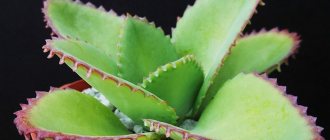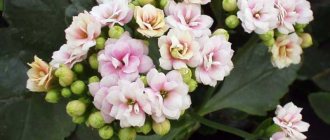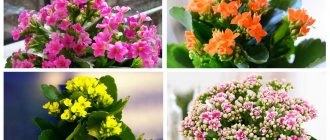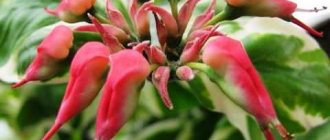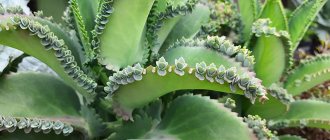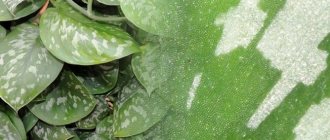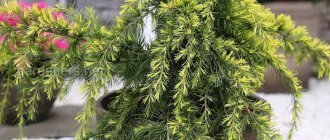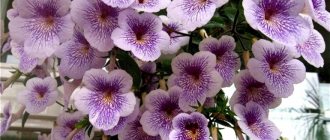Appearance
Varieties of Kalanchoe share several main external characteristics:
- the root system is fibrous, with a short and branched rhizome; the roots are located in the upper part of the soil;
- dense, succulent stems are abundantly covered with foliage;
- the shape of the leaves varies depending on the type of succulent: oval, jagged, heart-shaped, narrow or lobed;
- the leaves are fleshy, rich green, less often dark purple;
- flowers are united in paniculate inflorescences, about 10 specimens in each inflorescence;
- the tree of life blooms with buds of yellow, red, white, purple or orange; flowers four-membered, erect or drooping;
- bears fruit with multi-seeded leaflets.
Most varieties of Kalanchoe grow and develop well under the supervision of plant growers.
Botanical description
ATTENTION : Kalanchoe stands out for its juicy green stem (quite thick) and the same leaves, the leaf shape is oval or elongated, the root system is superficial, branched. Various flowers (small and large) are collected in lush inflorescences; the colors of the flowers are very different - from delicate pastel tones to bright rainbow ones.
This plant appeared from the tropics; it was brought by sailors to Europe from long journeys. Initially, only medicinal Kalanchoe was distributed, and then purely decorative varieties appeared. This plant has many faces, it has several other names - “surgeon without a knife”, “home doctor”, “tree of life”, “sneezer”, and all of them are true in essence.
Types of Kalanchoe domestica
Not all varieties of Kalanchoe have been “domesticated” and submitted to humans. The most popular among plant growers are 20-30 varieties, in particular hybrid ones.
Bentha (Kalanchoe bentii)
This subshrub, up to 1 m high, comes from the Arabian Peninsula. The succulent has oval, large and thick leaves. Blooms with red, white, lemon flowers. This variety begins to bud in mid-spring.
Cirrus (Kalanchoe pinnata)
A large crop up to 1 m high. Rich green oval leaves are rounded at the edges. The buds are of an unusual shade - the white tone softly flows into green. The flowers are grouped into inflorescences and hang in clusters.
Beharskoe (Kalanchoe beharensis)
A native of Madagascar, it is distinguished by its large height - up to 3 m - and bizarre leaf shapes. The surface of the plates seems to be smeared with grayish wax.
The apical shoots are covered with inflorescences with small buds. Blooming Kalanchoe Beharskoe is covered with red, orange and pale yellow buds. The crop tolerates drought well, but develops better in late autumn and winter.
Large-flowered (Kalanchoe grandiflora)
The homeland of this succulent is India. Outwardly it resembles a variegated variety, but the leaves of the large-flowered Kalanchoe do not have a pronounced pattern.
Grows up to 50 cm in height. The stem grows upright, with light green leaves clustered around it. If the large-flowered tree of life grows directly under the sun, the leaf blades gradually turn pink.
Flame (Kalanchoe flammea)
Culture from the rocky Somali expanses. The leaves resemble an inverted egg, the plates are thinner at the base. The buds are bright orange and deep red.
The flame succulent does not exceed 40 cm in height and does not branch. This is one of the most capricious and demanding varieties to care for.
Blossfeldiana (Kalanchoe blossfeldiana)
A common species, reaches a height of 40 cm. The stems are weakly branched, the leaves are ovate, dense, edged with red. Miniature buds are grouped into multi-flowered inflorescences.
Kalanchoe Blossfeld has several varieties. In nature, this culture blooms with red buds. But experts have managed to develop hybrids with other shades of flowers.
Varieties with simple flowers
Some varieties of Kalanchoe Blossfeld bloom with small flowers with 4 petals. These include:
- This crop has unusual leaves of a light green hue, covered with pink, cream, white stripes and chaotic spots. The edges of the plates are decorated with a reddish border. The variety blooms with coral or red buds.
- Shell Pink. Up to 60 buds can develop simultaneously on each peduncle. The greenish-white shade of the petals gradually turns into soft pink.
- Orange Triumph and Tom Thumb Tetra. Representatives of these varieties grow up to 30 cm in height. The leaves are large, wide, the flowers resemble small stars in orange and red tones. Both varieties are suitable for decorative home decoration.
Most varieties of Kalanchoe with simple flowers are used for decorative purposes. They look no less impressive than when combined with double flowers.
Varieties with double flowers series
The flowers of some varieties of Kalanchoe look like small roses. Terry is formed due to the number of petals - some varieties have up to 32 pieces on one flower.
Kalandiva
A greenhouse variation of Kalanchoe Blossfeld, but unlike its parent, it is more compact. The peculiarity of this variety is its lush double flowers.
20-50 buds grow on one succulent stem. The maximum height of the plant is 30 cm. There are 2 subspecies of the variety:
- Mix. A miniature bush decorated with small lush flowers of different tones: orange, yellow, red, white.
- Mini. A small bush with numerous shoots and round, thick leaves. Buds red, yellow, pink.
Kalandiva blooms for a long time - up to six months, starting in February.
Rosalina
A distinctive feature of this variety is double flowers and rounded glossy leaves. The blooming delicate buds are yellow, purple, white or pink. Rosalina grows up to 30-40 cm.
Roseflower
A hybrid variety with small buds that are grouped into inflorescences. Double flowers are similar to miniature rose flowers in yellow, pink and white. Roseflower grows up to 30 cm in height.
Mangina (Kalanchoe manginii)
Growers often grow this variety in pots. As they grow, Mangina shoots droop, reaching 40 cm. The leaves are round, purple or green. Pink bell flowers hang from the stems in clusters. Miniature Mangina rarely grows above 15 cm.
Tomentosa (Kalanchoe tomentosa)
The variety is also called tomentosa. Succulent up to 45 cm high with erect stems. Due to the bizarre shape and fluff on the leaves, tomentosa is also called “cat ears”.
In nature it blooms with small pubescent bell-shaped flowers. Even with very good care, it produces buds very rarely.
Paniculaceae (Kalanchoe thyrsiflora)
Grows up to 50 cm in height. The leaves are white-silver, rounded at the ends. Leaves are more common at the bottom than at the top.
The type of inflorescence is a panicle, yellow buds with miniature petals. Kalanchoe thyrsiflora blooms in late April - early May.
Trumpetflower (Kalanchoe tubiflora)
Large succulent, reaches 60 cm in height. The stems are long and thin. The leaves with a greenish tint are decorated with brownish and grayish spots. Numerous buds are colored in red, violet, lilac, white and pale yellow.
Daigremontiana (Kalanchoe daigremontiana)
Also called Kalanchoe bryophyllum. A large succulent grows up to 50 cm in height. The front side of the leaves is gray-green, the back side is bright green. The leaves are covered with purple pigments. The inflorescence is paniculate; the succulent most often blooms in winter with pinkish and purple buds. It is not easy to “persuade” representatives of this variety to bloom at home.
479 photos of different types of succulents and rules for growing them at home
On a note. Kalanchoe degremona reproduces in a very interesting way. Buds appear in the gaps between leaf teeth in winter. Gradually, shoots with small aerial roots develop from them. When they mature, they fall into the ground, after which their new life cycle begins.
Marble (Kalanchoe marmorata)
This variety is distinguished by wide and variegated leaves, similar to an inverted egg. For this feature, marble Kalanchoe is also called variegated. The leaf blades are covered with brown, green, purple, brown dots.
The variety's homeland is Ethiopia. The decoration of the marble variety is not only bright leaves, but also white flowers with 4 petals.
Dissected (Kalanchoe laciniata)
This variety of Kalanchoe is called differently - lobed, dissected, “sea of gold”, laciniata. The culture is distinguished by its original feathery leaves: their surface seems to be waxed, and the edges of the plates are serrated. For these unusual branched leaves, the plant is also called “deer horns”.
The fleshy, juicy stems initially grow vertically, but gradually begin to droop. Yellow or orange flowers of a simple shape, with 4 petals, are arranged singly.
Tessa (Kalanchoe Tessa)
One of the most attractive varieties of Kalanchoe. It grows up to 30 cm high. Tessa is a variety of Kalanchoe Mangini. The shape of the stems is creeping, such a plant will look advantageous in a hanging pot. The bell-like drooping flowers are large, up to 2 cm. The orange buds look attractive against the background of green oval leaves.
Alochoe (Kalanchoe porphyrocalyx)
Also called purple-colored. A unique variety of the tree of life: can grow in almost any environment.
The succulent climbs tree trunks or settles on rocky soils. Bell flowers are painted in 2 colors: purple and yellow.
Lucy (Kalanchoe luciae)
Kalanchoe Lucy (Lucia) is a crop with hard, large leaves. A bluish coating is visible on the upper plates, while the lower plates are purple and green in color.
Lucia leaves are placed vertically. The culture blooms with white flowers in the third year of life. May wilt after flowering.
Dwarf (Kalanchoe pumila)
The Tree of Life, originally from Madagascar, is a true Lilliputian among other varieties. The shrub rarely grows more than 20 cm in height. The erect stems droop as the succulent grows.
The leaves look like a fan with a wavy edge. The plates of a young plant are dark green, gradually turning purple or brown. The buds are bright, pinkish-violet.
Serrated Kalanchoe (Kalanchoe serrata)
Tall variety with erect stems. The triangle sheets are painted in light green tones. If the succulent grows under the sun, the leaves will change color to pink or purple.
The culture blooms with tubular buds, pink or orange. The zurben variety is viviparous, like the degremona variety.
Light green (Kalanchoe laetivirens)
The crop is up to 30 cm high. The leaves are oval, the plates are uniform, light green. It blooms with miniature yellow-orange buds.
A light green variety, like degremona or jagged, viviparous. In Kalanchoe laetivirens, brood buds appear between the teeth along the leaf edge.
Fedchenko (Kalanchoe fedtschenkoi)
It grows up to 30 cm in height. The dark green leaves are thick, oval, and toothed. If the flower grows in the sun, the leaves become pinkish around the perimeter.
Kalanchoe Fedchenko blooms with drooping bell-shaped buds. The flowers are of an unusual shade - pinkish-salmon.
Spreading (Kalanchoe prolifera)
Madagascar succulent is almost 2 m high. The young culture has strong and erect stems. Gradually, the plates under the stem fall off, and only the top remains covered. The succulent blooms for the first time at 3-4 years of age. The buds are beautiful, miniature yellow-orange.
Marnier (Kalanchoe marnieriana)
A subshrub with fleshy leaves grows on the rocks of Madagascar. The Marnier variety grows up to 50 cm tall.
The oval leaves are colored pinkish-lilac in winter, which makes the bush attractive. Reddish or orange buds droop down.
Loose-flowered (Kalanchoe laxiflora)
Another native of the rocks of Madagascar, up to 50 cm high. It is distinguished by the original color of its leaves. Their base is bluish-green, and along the perimeter the plate is surrounded by a red-brown border. Some varieties have completely red plates. This succulent resembles Kalanchoe Mangina, but the loose-flowered version is larger in size.
The ovoid leaves are decorated with serrations. The buds delight the eye with orange-lilac, pinkish-violet and red tones.
Gastonis bonnieri (Kalanchoe gastonis bonnieri)
Also called yellow Kalanchoe, it is a native of Madagascar. It is called “donkey ears” because of the unusual shape of the leaves. It reaches a height of 50 cm.
The tender leaves are colored brownish or red, and the upper young plates are silvery. In February, yellow buds shoot out on the flower stalks.
Sinsepala (Kalanchoe synsepala)
A succulent that has managed to adapt to any weather conditions. Grows on uneven rocky soils and slopes. Large serrated leaves are edged along the perimeter with burgundy.
White or pinkish small buds form on panicle inflorescences.
Kalanchoe figuereidoi
A crop that grows up to 1 m in height. Greenish-gray leaves bloom in the form of rosettes. The edges of the plates are surrounded by a purple border. It is due to this unusual coloring that Kalanchoe resembles a partridge. In winter, the color of the leaves is brighter.
“Partridge” blooms in winter with small pink buds.
Hilderbrandt (Kalanchoe hildebrandtii)
Shrub up to 40 cm high. Silvery leaves look like coffee spoons. Bright orange large buds stand out in an original way on the unusual leaf plates.
Varieties, forms, cultivars
Breeders have developed several varieties of felt Kalanchoe, with Chocolate Soldier being especially attractive. This is a compact dense bush, up to 25 cm high. The fluffy leaves have an intense orange-chocolate color along the edges.
Some others:
- Kalanchoe tomentosa 'Silver Panda' (most common)
- Kalanchoe tomentosa 'Teddy Bear' (with rounded yellow-brown leaves with chocolate markings on the edges)
- Kalanchoe tomentosa 'Cinnamon' (reddish brown)
- Kalanchoe tomentosa 'Black Tie' (a brighter, lighter version of Silver Panda)
Bibliography:
- International Crassulaceae Network, https://www.crassulaceae.ch/
Conditions for keeping Kalanchoe
The Kalanchoe succulent is considered an unpretentious and hardy plant. But some nuances of caring for it still exist.
Temperature
The tree of life is a crop resistant to temperature changes. At temperatures above 10 C°, Kalanchoe can be taken out into the air. On warm summer and autumn days, the succulent is comfortable on the balcony. And although the tree of life also tolerates heat well, in the summer it is worth increasing the frequency of watering.
The optimal temperature in winter is 12-16 C°, in summer – 23-25 C°.
With the onset of winter days, it is better to lower the air temperature in the room where the Kalanchoe lives. This way the plant will gain strength for future flowering. This condition is not necessary, but if it is not observed, the flowers will be small and inconspicuous. You should not allow the temperature to drop below 10 C° - in such cold the succulent can get sick.
Humidity indicators
This plant suits medium humidity. Kalanchoe will easily tolerate short-term increases in humidity or short periods of drought. Also, you should not settle it next to crops that themselves know how to humidify the air (for example, spathiphyllum).
Lighting
Kalanchoe loves sunlight, but to grow and bloom it only needs to be in the sun 6-8 hours a day. Here you need to find a balance - darkness is destructive for a succulent just like direct rays of the sun. The culture grows best in the partial shade of the western part of the room. The south-eastern or eastern side is suitable for flowering crops.
In winter cold, when the sun's rays are not too aggressive, Kalanchoe can be placed on the south side - the plant needs additional light. If it is not possible to move the pot to the south, it is better to illuminate the flower with lamps.
Where to keep
You should not place the tree of life in the back of the room - here the succulent will lose its decorative properties. The buds will fade, the color of the leaves will lose their saturation, and the succulent will not bloom for long.
In summer, it is better to move Kalanchoe to a veranda or balcony. Fresh air will cool the leaves, the flower will not suffer too much from the bright sun. In other seasons, it is better to place it close to windows - this way the succulent will receive the amount of light it needs.
Lighting and location
The plant loves bright light, but gets tired from being left for a long time.
The optimal amount of time in the light is 10–12 hours. Some gardeners cover the flower with a curtain at night so that it can rest from the light. It is recommended to place the pot with the plant on the east or west side with diffused lighting, and in winter - on the south.
Caring for Kalanchoe at home
Kalanchoe needs proper watering, fertilizing and pruning.
Priming
Kalanchoe grows well in fertile soil with a slightly acidic or neutral reaction. To prepare the substrate, you need to mix humus, sand, peat, turf and leaf soil in equal proportions. You can also use universal soil by adding expanded clay or perlite.
Pot
For Kalanchoe, a ceramic or plastic container with protrusions on the bottom is suitable. The succulent also feels good in clay pots. The main thing is that there is enough free space in the future home.
Grow bell seedlings without making mistakes: 5 useful tips
You cannot transplant a small Kalanchoe into a large pot in the hope that the succulent will grow over time. The plant will spend all its vital energy on root growth and will leave nothing for the buds. It is unacceptable to grow the tree of life in the same pot with other plants.
Watering
The tree of life accumulates moisture in its leaves and withstands drought. Excessive watering and stagnation of water cause the roots to rot. This is dangerous for the development of fungi and rot. Therefore, Kalanchoe needs to be watered abundantly to moisten the entire lump of earth. But the remaining moisture needs to be drained. The frequency of moistening depends on the soil moisture - the soil must have time to dry between waterings.
In winter, the plant is watered every 10-14 days, in summer - once a week.
When watering, water should not fall on the leaves.
Spraying
Kalanchoe does not need additional heavy spraying. The tree of life can be given a cool shower, but only in the intense summer heat. Periodically, the sheets can be wiped with a damp cotton pad. This procedure will be quite sufficient for the succulent.
Fertilizer
Hardy Kalanchoe, unlike other indoor crops, does not require frequent feeding. The tree of life can be fed with cactus fertilizer once a month. It is better to do this between June and October. This way the succulent will store nutrients for future flowering.
The fertilizer should not contain a lot of nitrogen, otherwise the Kalanchoe may rot.
Trimming
For better development of Kalanchoe, pruning is necessary. After flowering, the flower stalks are cut as low as possible so that the remaining parts do not rot. The plant no longer needs them and only consumes the nutrients and energy of the Kalanchoe.
To prevent the crop from growing, in the summer you need to pinch off the tops at the growing point. This procedure stimulates the growth of lateral stems. Otherwise, the flowers will accumulate only at the top. After pinching, the plant looks more beautiful and lush. To make the Kalanchoe even more lush, you need to wait until the side shoots produce 4-5 leaves. Then the pinching procedure is repeated.
An ordinary stationery knife with a sharp blade is suitable for trimming. It must be disinfected before use.
Transfer
The plant is replanted when it becomes crowded in the pot. You can relocate a Kalanchoe if it has suffered from excessive watering, exposure to pests, diseases, etc.
Transplant stages:
- Prepare a container of suitable size. The diameter of the new home should be several centimeters larger than the previous one. You should not take a container that is too spacious - you will have to wait a long time for the buds.
- Lay out drainage as the first layer: expanded clay, crushed stone, stones.
- Carefully remove the plant from the old container.
- Carefully examine the roots to see if there are any damage or symptoms of disease. Damaged or diseased specimens are removed. The cut areas should be washed with a solution of potassium permanganate.
- The succulent is placed in a prepared container and covered with soil to the desired level. The earth does not need to be compacted too hard, just press it with your palms.
- Water the flower with water mixed with a growth stimulator.
It is believed that it is better to root the tree of life into a new container in March. During this period, the succulent usually fades and “moving” will not be stressful for it.
Nuances in winter
How to care for the tree of life in the cold season:
- there is no need to place the culture in a place that is too warm;
- watering is reduced to once every 2-3 weeks;
- the plant still requires light 6-8 hours a day, then complete darkness;
- If a grower starts a young Kalanchoe in winter, it needs to be pinched at the top for intensive growth in width.
From February to March, most varieties of Kalanchoe begin to bloom. Conditions for crop care are changing.
During flowering
You need to care for blooming Kalanchoe according to the following algorithm:
- water moderately (moisten when the soil is completely dry);
- provide lighting mode (daylight hours 6-8 hours);
- protect the succulent from cold and drafts;
- trim off wilted leaves and flower stalks.
During the flowering period, fertilizing is applied once a week, but the portions of fertilizers are reduced.
Rest period
Kalanchoe rests in the second half of autumn, accumulating strength for future flowering. During this period, it is better to reduce the air temperature in the room to 15-16 C°. Gradually you need to stop applying fertilizers. Watering becomes rare and less abundant.
Where and how to plant a flower?
- Planting is carried out in the spring (April or May).
- Plastic or ceramic pots are suitable for the plant. There should be drainage holes at the bottom of the container.
- The size of the pot depends on the plant. Kalanchoe blooms better in tight containers. A large pot can provoke the development of the root system and foliage, which harms the plant.
- Before planting, the pot is disinfected. For these purposes, a concentrated solution of manganese, boric acid or ordinary laundry soap is suitable.
Attention! After disinfection, it is important to dry the pot.
Landing instructions
When planting, you should follow these recommendations:
- The day before transplanting, water the flower.
- Pour expanded clay onto the bottom of the pot and add a nutrient substrate.
- Add some soil.
- Place the plant in the middle of the pot, align it with the root collar. It should be 0.5–1 cm below the edge of the pot.
- Sprinkle with soil on all sides.
- Water after planting using a spray bottle.
- Leave the plant for 3-4 days in a dark room.
Drainage must be added to pots with Kalanchoe . Expanded clay, crushed brick or charcoal are used.
Reproduction of Kalanchoe
Kalanchoe is propagated by cuttings and leaves, less often by seeds.
Cuttings
For this type of propagation, shoots with a length of at least 8-12 cm are chosen. The apical shoots take root best. Cuttings can be carried out in two ways:
- Cut the cutting from the parent, set aside for a day to dry, remove the lower leaves. Moisten the soil in the pot and plant the cuttings in it. The succulent takes root after 2-3 weeks.
- Prepare the cuttings as described above. Dip it in water half the length of the stem. The water container should not be exposed to direct sunlight. After 2-3 weeks, when the roots appear, the shoot can be moved to a permanent place.
Leaf
Even a novice florist can do this procedure. The Kalanchoe leaf is cut and planted in well-moistened soil. A “dome” is constructed from a glass jar on top. The roots develop after 3-4 days. After this, the succulent begins to grow quickly.
For planting, you can take fallen, but not yet dried leaves. But they are first placed in a glass of water and transplanted into the soil after the roots appear.
Seeds
This method is suitable for the cool season. The seeds are scattered on top of the soil, without deepening them, but only lightly pressing them. Water with a small stream of water - a small depression will be created in the soil. The seeds are covered on top with glass or a small piece of cloth. Future sprouts are protected from sunlight.
After the shoots emerge, they are moved to a box, which is covered with polyethylene on top. You can plant sprouts in separate small pots only when 4-5 leaves appear on them. New kalanchoes will bloom in about a year.
How to make Kalanchoe pinnate bloom
The succulent begins to bloom in its second year. But flower growers at home often cannot achieve its flowering. The main reason for this will most likely be inappropriate living conditions.
To achieve flowering of Kalanchoe pinnate, several conditions must be met:
- The plant blooms mainly in autumn or winter, when daylight hours are minimal. The time the succulent stays in the dark is at least 12 hours and 12 hours under the influence of dim lighting.
- It is also necessary to keep the plant in a cool room with a temperature no higher than +15°C for 6 weeks.
- During this period, watering should be suspended and increased when buds begin to form.
Frequent illnesses
With proper care, Kalanchoe rarely gets sick. But from time to time, the succulent can be affected by gray mold or powdery mildew.
Powdery mildew
A dangerous fungal disease occurs from excessive humidity. Kalanchoe affected by powdery mildew begins to shed its leaves and then dies completely. At the first suspicion of a disease, the gardener should begin to treat the tree of life. Powdery mildew is an infectious disease and can quickly spread to other green plants.
The sick plant must be isolated from the rest of the household. The disease is fought with fungicides Aktarofit, Fitoverm, etc.
Gray mold
It is impossible not to notice this fungus - it spreads to all parts of the plant. Brown watery spots are visible on the stems, and grayish dust accumulates in small piles on the leaves.
Gray mold affects plants that have been watered incorrectly or irregularly. That is why it is important to prevent constant stagnation of moisture in the soil. Fallen leaves must be removed from the pot to prevent the development of fungus. The soil is partially replaced, the Kalanchoe is treated with a fungicide and placed closer to the light.
Actellik and Commander are suitable medications. They treat the plant twice with an interval of 2 weeks. Solutions are prepared according to instructions
↑ 5 Kalanchoe leaves - a simple way to strengthen the immune system
Kalanchoe pinnate (Bryophyllum pinnatum) is an effective recipe for restoring human immunity. It can be used both before an impending epidemic of infectious diseases and during their treatment. What is the difference between Kalanchoe pinnate and Kalanchoe Degremon.
Folk recipes
- For a runny nose: squeeze the juice out of the leaf and put 1-2 drops into your nose once or twice a day.
- For inflammatory processes of the gastrointestinal tract and kidneys, drink 1 tsp. juice 3 times a day.
- For varicose veins: fill a half-liter bottle with chopped Kalanchoe leaves and fill to the top with vodka or 70% alcohol, place in a dark place and shake periodically. After a week, the tincture is ready. Rub your feet with the tincture, starting from the feet, moving to the knees and above. The pain in the legs will go away quickly, but to cure the network of veins, the procedure must be carried out within 4 months.
- For cervical erosion (in the initial stage), 10-15 applications with juice, and the erosion is delayed.
- For warts: cover the wart with crushed leaves, tie and hold this compress for a while.
- For mental and physical fatigue, chew and swallow a fresh leaf. After 15-20 minutes, the body is restored and performance returns.
- For psoriasis, tie crushed Kalanchoe leaves to the affected areas.
- For inflammation of the middle ear, instill 1-2 drops of Kalanchoe tincture at night.
- For purulent wounds, boils, skin abscesses, eczema, herpes, burns, drop 2-3 drops of juice onto the affected parts of the body several times a day. The wound heals quickly and disappears. The course of treatment is 5-6 days. For burns, mix the juice with protein and apply to the affected areas.
- For sinusitis, dilute the juice with boiled water in a ratio of 1:2 and suck through the nose. Everything goes away in a week.
- For vitamin deficiency and loss of strength, add one leaf to salads.
- For gum inflammation, rinse your mouth with an infusion of crushed Kalanchoe leaves.
- For inflammation of the eyelids, drop 1-2 drops of juice onto the eyelids 3-4 times a day.
- For blepharitis, conjunctivitis, sore throat, tonsillitis, stomatitis: pour 2 tablespoons of crushed leaves with a glass of boiling water, simmer for 2-3 minutes, then let the broth cool and strain. Rinse your eyes with it three times a day and gargle.
- For flu, for prevention, lubricate the nasal mucosa with juice 2-3 times a day. In this way, an epidemic can be avoided. It is believed that houses that have 2-3 flowerpots with Kalanchoe will avoid the flu.
- For mastitis, lubricate the juice 2-3 times a day around the nipples, make compresses with it 3 times a day on the swollen mammary glands. The temperature drops and everything goes away.
- For tuberculosis, take 1 tsp. juice diluted with water 1:2, twice a day after meals.
- Ointment. In a clean cup, mix 30 ml of juice and 50 g of pure lanolin. Add 50 g of Vaseline to the slurry and mix until smooth. Use for boils, trophic ulcers.
- For trophic, post-thrombophlebic and post-traumatic ulcers: fold gauze or a wide bandage three to four times, moisten it generously with freshly squeezed juice and apply to the sore spot. Change the dressing daily.
- For burns: apply crushed leaves to damaged skin for two hours.
Kalanchoe pinnate can reduce immunity if used uncontrolled.
Major pests
In addition to diseases, Kalanchoe can be attacked by insect pests.
Aphid
It settles on the leaves of the tree of life and feeds on their juice. It can get on the plant from other crops, clothes and shoes of household members, or even fly out the window.
Small accumulations of harmful insects are removed with a solution of soapy water (combine laundry soap with water in a ratio of 1:6). A large number of aphids are destroyed with special preparations: Actarofit, Actellik, etc.
Shchitovka
Mobile small insects whose body is covered with a waxy shield. Kalanchoe affected by cabbage cannot develop normally - it misses flowering and sheds yellowed leaves. Like aphids, scale insects settle on the lower part of the leaf.
Brown bugs can be seen when examining a succulent. You can remove pests from the leaves with your hands or wipe the green plates with alcohol. Next, the Kalanchoe is washed with soapy water and treated with an insecticide.
Healthy and powerful melon seedlings: 5 wisdom for good results
Spider mite
It entangles plants with a white coating that resembles a cobweb. The leaves begin to harden and brown spots appear on them. To combat ticks, use the drug Fitoverm or use a soap solution.
Mealybug
The pest feeds on the sap of the tree of life. Provokes the growth of black mold. Settles on new shoots and leaf axils. The main sign of mealybug infestation is a white waxy coating on the leaves.
Parts of the plant affected by the scale insect are removed. The leaves are sprayed with mineral oil. If the damage is very extensive, you can use insecticides: Komandor, Fitoverm, Aktara, etc.
Problems during cultivation
The unpretentious Kalanchoe can still make the grower fuss about it. The reason is diseases and pests.
Stretched out
If the Kalanchoe begins to grow rapidly upward, you need to gradually remove the top leaves. New shoots will subsequently grow on them. The leaves are removed until the Kalanchoe looks like a neat bush.
The roots are rotting
The roots rot in crops that are watered too often and abundantly. Due to damage to the root system, the entire plant gradually begins to suffer: the leaves droop and fall off. The stem of the flower will indicate rotting of the roots: it will become soft and brown at the base.
To solve the problem, you need to remove the Kalanchoe from the pot and examine the earthen ball. All weak, watery, grayish roots with signs of rot need to be cut off. Transplant the tree of life into new soil and follow the watering regime in the future. It is necessary to moisten the earthen ball only when the soil is completely dry after the previous watering.
Leaves turn yellow
Yellowed Kalanchoe leaves are a sign of improper care. It is necessary to balance the regime of fertilizing and watering, to provide the succulent with enough sunlight.
Leaves fall
If your Kalanchoe is dropping its leaves, the air in the room is probably too musty for it. The room needs to be ventilated more often.
The leaves are drying
If in the summer the leaves of the tree of life turn yellow, dry out, and then begin to fall off altogether, the plant has been infected by aphids. The leaves are treated with a soap solution, the procedure is repeated after a week. It is also important to provide the Kalanchoe with optimal humidity and timely water it with settled water.
If the leaves are severely affected by aphids, the affected plates are removed from the stem.
The leaves are curling
Curling leaves are a sign of excess nitrogen in the soil. It is better to transplant Kalanchoe into more suitable soil.
Spots on leaves
The solution to the problem depends on the color of the spots:
- Brown. Kalanchoe was affected by dropsy. It occurs as a result of waterlogging and temperature changes. The tree of life should be placed in a dry and warm place, and the amount of water when watering should be reduced. The succulent should not be exposed to cold air.
- White. White coating on the leaves occurs due to too hard water for irrigation. It probably contains impurities of lime and salt. Water needs to be filtered or settled. You can freeze it for future use and water the Kalanchoe with thawed water.
Blackening
The leaves of the tree of life turn black due to fungal infection. The reason for this is excess moisture in the soil; the soil does not have time to dry out. The soil needs to be changed, sand added to it - this will increase the looseness. Additionally, you need to adjust watering, water the plant less often and with less liquid.
Slow growth
If Kalanchoe first slows down in growth and then stops growing upward altogether, the reason lies in the soil. Its composition is not suitable for the plant, it is too poor. The problem is solved by fertilizing. If after this, after 2 weeks, the tree of life has not started to grow, it is transplanted into fresh soil.
Small leaves
Leaves become dull and smaller due to lack of light. Affected crops should not be left on northern windows; it is better to move them to a sunnier side. This is especially true for the tree of life during the period of flowering and bud formation. The succulent can be helped with fertilizer (apply once every 2 weeks).
Pallor of the plant
Kalanchoe castings have turned pale and soft - the plant receives too much sunlight. The culture needs to be moved to a semi-dark place where direct rays of the sun do not fall.
Doesn't bloom
The tree of life refuses to bloom for several reasons:
- Insufficient lighting. Not receiving the required amount of light, the plant spends all its energy reaching towards the sun. There is no energy left for flowering. Kalanchoe needs 9 hours of daylight, after which the culture must plunge into darkness.
- Incorrect feeding. The plant does not bloom because it is overfed with fertilizers containing nitrogen. Kalanchoe obediently grows green mass and is in no hurry to bloom. It is necessary to reduce the frequency of fertilizing and their dosage.
- Excess watering. It negatively affects the roots of Kalanchoe and interferes with the normal development of leaves and flowers.
↑ Medicinal properties and treatment of Kalanchoe
Kalanchoe greens in their chemical composition contain: polysaccharides, enzymes, micro- and macroelements (magnesium, manganese, aluminum, calcium, iron, copper, silicon), vitamin P, organic acids, tannins, flavonoids. Thanks to this life-giving set of active substances in a unique ratio, Kalanchoe has a bactericidal, bacteriostatic and anti-inflammatory effect. Promotes rapid cleansing of wounds and ulcers from necrotic (decaying, decomposing) tissues and rapid epithelization (tightening, healing) of the wound and ulcer surface.
Based on Kalanchoe pinnate, three main medicinal preparations can be prepared at home: juice, ointment and extract.
↑ Juice
Kalanchoe juice is effective for the treatment of trophic ulcers, non-healing wounds, bedsores, fistulas, burns, fresh surgical sutures, inflammation of the gums and oral mucosa, stomatitis, gingivitis, chronic tonsillitis, eye diseases, inflammation of the eyelids. For women giving birth, it will help with ruptures after childbirth, perineal wounds, cervical erosions and cracked nipples. Apply the juice externally in the form of a gauze bandage or napkin in several layers, generously moistened with juice and internally, in the form of rinses.
In some cases, the juice can be used without bandages, applying 2-3 drops to the sore spot for several days until the desired effect is achieved. To prevent flu, for colds and runny nose, the juice is instilled daily 2 times, 2 drops in each nostril. It is known that Kalanchoe juice is used to treat tuberculosis by taking juice diluted three times with water, 1/2 teaspoon 2 times a day after meals.
The juice is obtained from August to November, when the maximum amount of useful and biologically active substances accumulates in the leaves and stems. Just like aloe, Kalanchoe juice must undergo special processing. Different sources provide slightly different methods for obtaining juice, the essence of which boils down to the following technology:
The aerial part is cut off, washed, dried with a paper napkin, wrapped in any natural fabric and placed in the refrigerator at a temperature of 5°C-7°C for a week (no more). It is believed that during this time, intensive synthesis of biostimulant substances takes place in the greenery and Kalanchoe acquires the true medicinal properties inherent in it. Then the leaves and stems are cut as finely as possible, kneaded to a pasty state and squeezed through cheesecloth. The resulting juice is left to stand for 3 days, placed back in the refrigerator, filtered through a fine sieve or the same gauze in several layers and sterilized for 20-30 minutes.
This juice can be immediately used for its intended purpose, but it is not stored for a long time, therefore, it is usually preserved by mixing with medical alcohol to a solution strength of 20% (in the pharmacy version, the juice is preserved with chloroform). The canned juice is poured into small glass containers, sealed tightly and stored in the refrigerator (preferably at the top on the side wall). Shelf life - no more than a year. Before use, the juice is heated in hot water to human body temperature.
This recipe does not at all imply that you cannot use the “services” of Kalanchoe at other times. As much as possible! Just cut off a couple of large lower leaves, squeeze out the juice and use for your medicinal needs. In any case, this juice has its beneficial medicinal effect.
For varicose veins, a slightly different recipe for preparing juice, or rather tincture, is used. To do this, take crushed Kalanchoe leaves and fill a container (bottle, jar) halfway with them, fill it to the top with vodka and leave it in a dark place for 7 days, shaking it daily. After time, the tincture is filtered and stored in the refrigerator. Used to rub feet. Rub from feet to knees.
↑ Ointment
There are a couple of recipes for homemade Kalanchoe ointment:
- Ingredients: 30 g of Kalanchoe juice (fresh or canned), 50 g of medical petroleum jelly, 50 g of anhydrous lanolin (lanolin is a fat-like substance based on wool wax, can be purchased at the pharmacy). First, mix the juice with lanolin and heat it in an enamel container, without bringing it to a boil. Then Vaseline is introduced into the heated mixture in portions until completely dissolved. The finished ointment is poured hot into a glass container disinfected with alcohol. Store in the refrigerator. People prone to allergic reactions should not use this method of making ointments, since lanolin increases skin sensitivity and can cause allergies.
- Ingredients: Kalanchoe juice and melted pork fat in a 1:1 ratio. The ingredients are mixed and heated in a water bath for 45 minutes, without allowing the mass to boil. Remove from heat and leave for a day in a warm place. The procedure is repeated three times, filtering the hot mass. Also pour into a glass container and store in the refrigerator. This ointment is not allergenic and can be used without restrictions.
The ointment is used to heal perineal wounds, bedsores, ulcers and wounds, mastopathy and cracked nipples.
↑ Extract
Crushed leaves and stems of Kalanchoe in a ratio of 1:5 are poured with boiling water and placed in a water bath for 15-20 minutes. Strain and put back on the fire, bring to a boil and evaporate to half the volume. Cool and pour into a glass container. Store in the refrigerator. The extract is used as a biostimulant for the treatment of skin ulcers, non-healing wounds, and fistulas. The extract and juice are very useful for preventing gums by rubbing them in with your fingers every day. If you perform this procedure regularly, you will get healthy gums and strong teeth.
It is interesting that some advanced Kalanchoe lovers eat it fresh as ordinary vegetable greens. It is said that daily intake of a small amount of fresh greens of this plant has a general strengthening effect on the body, cleanses the blood, stimulates the immune system and prevents aging of the body. Fresh, finely chopped leaves are added to salads, vinaigrettes or consumed separately with the addition of vegetable oil and lemon juice.
Despite the apparent abundance of information, it is obvious that the medicinal properties of Kalanchoe pinnate have not yet been fully studied, and the recipes for its use are far from being exhausted in this article.
Beneficial features
Juice is extracted from the fleshy leaves of Kalanchoe. It is used both in home and official medicine. Compresses and lotions from this miraculous remedy help with the following problems:
- non-healing wounds;
- sunburn;
- trophic ulcers;
- boils.
Kalanchoe juice helps with runny nose in children and adults. It is instilled into the nasal passages.
Kalanchoe has the ability to kill harmful microbes that fly in the air. Therefore, it is useful to place a tree of life in every room.
Is there any harm
For all its positive properties, Kalanchoe can cause harm. Succulent juice should not be used in the following cases:
- for oncology;
- for liver damage, hepatitis;
- if you are allergic to Kalanchoe juice;
- for joint diseases.
It is necessary to take products based on Kalanchoe juice with the approval of a doctor. Be sure to follow the dosage. Taking too much of the medicine will cause diarrhea or heartburn. When used externally, the juice can damage the skin and mucous membranes.
Signs and superstitions
Various folk signs and superstitions are associated with the tree of life:
- It is believed that unmarried women will get married faster if they plant a tree of life on their windowsill.
- Kalanchoe is also suitable for family people. The succulent refreshes the feelings of the spouses and protects the family hearth.
- Pregnant women are advised to propagate and replant the tree of life while pregnant. It is believed that after such procedures, childbirth will be easy and quick.
Sometimes the clanchoe suddenly and for no reason began to wither, even with good care. It has long been believed that the flower thus took upon itself a powerful negative energy blow and thereby warded off trouble from the household.
Recommendations from experienced plant growers
Some tips for growing Kalanchoe from experienced gardeners:
- You should not put Kalanchoe in a plastic container. Moreover, metal-plastic windows can also negatively affect crop growth. It is not always possible to place the tree of life away from plastic windows. But if this succeeds, the Kalanchoe will thank the grower with abundant flowering and rapid growth.
- The succulent blooms from February to March, but it can also be grown in greenhouses. Then flowering can be achieved at the very beginning of winter. The grower must provide the plant with bright lighting, regular feeding and proper watering.
- If it is not possible to maintain the room temperature above 10 C°, the Kalanchoe needs to be additionally illuminated and warmed with lamps.
Among the numerous varieties of Kalanchoe, there are both decorative and medicinal varieties. This culture is considered hardy and unpretentious in care, which is why plant growers like it so much. Kalanchoe is a plant with powerful energy, gives a person confidence in his abilities and keeps peace in the family.
